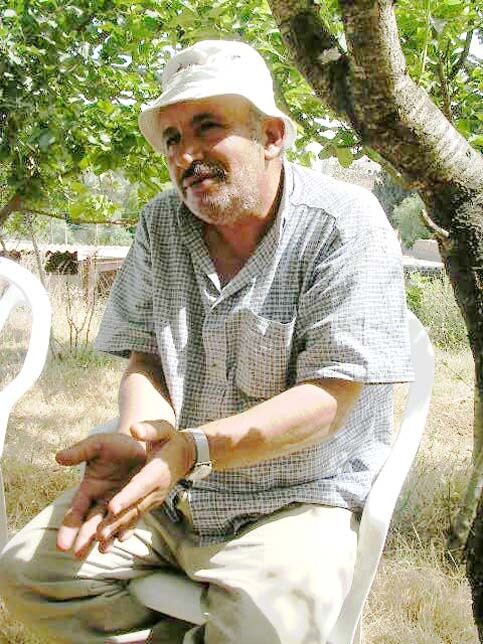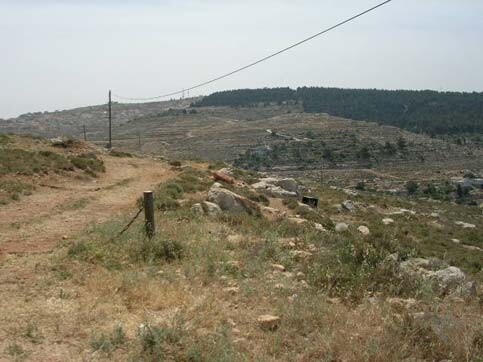The Electronic Intifada 16 June 2006

Musa Taha, a Palestinian farmer from the village of Qatanna. (Christi Hoover Seidel)
“When I was a boy, my family received a bag of flour from the United States,” tells Musa Taha, a Palestinian farmer from the village of Qatanna. It was right after the Nakba or “Catastrophe” of 1948 that left between 750,000 and 900,000 Palestinians as refugees, expelled from their homes and dispossessed of their land, that Musa remembers receiving this gift.
He tells us about the help Palestinians used to receive from the United States. In particular, he recalls his family receiving these relief sacks of flour. He vividly remembers the sacks themselves and the picture on the front of two clasping hands with the label “A present from the people of the U.S.A. to the Palestinian people.”
Today, in the village of Qatanna northwest of Jerusalem, Musa and his family, like so many Palestinians, are being severely affected by the separation barrier that the Israeli military continues to build, cutting deeply inside occupied Palestinian territory in the West Bank, aided by the support of the same United States that extended that helping hand over 50 years ago.

A visual image of encroaching colonization in Qatanna village. (Christi Hoover Seidel)
Palestinians from villages such as Qatanna, Biddu, and Qubeiba (many, like Musa, refugees from 1948) are unable to work in Israel as they used to and are increasingly turning to farming after years without work. Musa lives only 15 kilometers or 9 miles from Jerusalem. “Jerusalem is my city,” he says. But he cannot go there. Like his neighbors, Musa is cut off from Jerusalem, segregated into an isolated reservation with access only to neighboring Ramallah.
Thus the move to farming for many here. They are working the land for reclamation purposes, for resistance against an oppressive occupation, and because they simply have no other option. Unemployment is estimated by some to be as high as 60 percent here. They are trying to adjust to an isolated existence, seeking self-sustaining livelihoods.
One example of the harshness of everyday life for Musa and Palestinians like him is the realities imposed by Israeli “facts on the ground”—a phrase often used to refer to Israeli colonization of Palestinian territory. The Palestinian communities northwest of Jerusalem are surrounded by illegal settlements, namely of the Giv’at Ze’ev bloc, and are subject to settler harassment like the dumping of sewage into the valleys where their villages lie and being cut off from water sources. Land confiscation continues as these settlements expand around them in the creation of a “greater Jerusalem” that will cut the West Bank in half, isolating the north from the south.
The pursuit of this “greater Jerusalem” can be seen in the continuation of illegal settlement expansion coupled with the illegal demolition of Palestinian homes. The goal: to make life so difficult for Palestinians living in and around Jerusalem that they will leave, moving further into the West Bank. Some have referred to these efforts as “de-Palestinizing” Jerusalem, creating a Jerusalem without Palestinians that will: 1) cut the West Bank in half, isolating the north and south regions and 2) create such a large Jewish majority in this “greater Jerusalem” so that when the time comes to discuss “final status issues” such as the status of Jerusalem at the negotiating table, Israel can say that there are hardly any Palestinians living in Jerusalem, making it a final status non-issue.
For these Palestinians isolated in this reservation northwest of Jerusalem, open land for infrastructure and other development is limited. There are no hospitals, only clinics, and so health problems persist. There is no room for expansion, little access to universities, and thus restricted future prospects for the youth.
This is of great concern to Musa, who has 14 children and 29 grandchildren, many of whom live in one house. It is situated on the side of the hill that the settlement of Har Adar sits on. It is literally right above his home. The contrast is striking. He is unable to expand his housing for his children. He tried. He spent a year seeking permission to build another house on his land without success. Musa built it anyway. The Israeli military came and demolished it.
It was here one morning last year that he and his wife were sitting under one of their trees drinking their morning coffee when they heard bulldozers in the distance. The Israeli military came without warning and confiscated 12 of his 17 dunams of land (1 dunam = one-quarter of an acre), uprooting over 100 of his olive and fruit trees to make way for the wall. Every day for 17 years he had cared for these trees that he planted. In just one day they were all taken from him. The impact of this is devastating in more ways than one as any farmer who is so closely connected to the land would know.
Now, because of the Wall, Musa has problems with access to water and problems with the road to his home (it was destroyed by the Israeli bulldozers when they came to uproot his trees).
Musa tells us that he has no problem with Israelis. Like other Palestinians, he simply wants to live. He has conversations with Israeli soldiers even, trying to tell them his story. They usually play dumb and try to blame it all on Sharon and the government. But Musa looks forward to the day when a just peace will be known in this land. “We want for this day to come,” Musa says. “Maybe for our children. We want peace.”
When Musa sees films about other places in the world he says, “You feel sad. Why am I not like these other people in the world? Where is the future? There is no future. No hope.”
“Where is the hand?” Musa asks. “Where is this hand that gave us flour?”
Ever since he was a boy, the image of those two clasping hands symbolizing “A present from the people of the U.S.A. to the Palestinian people” stayed with Musa. He liked it. And it made him like America. He wanted to go there.
This perception was not uncommon among Palestinians or throughout the Middle East up until the middle of the twentieth century. For many, the United States was even viewed quite positively as a non- or anti-colonial power, not having imperialistic designs on the region, and engaged primarily in benevolent activities such as education and health care. Unlike other European powers, the United States was not seen as trying to impose its will on the peoples of the region, to occupy or colonize them. [1]
But this all changed in the latter half of the twentieth century. With the U.S. drive to develop a large military presence in the region, its quest to control directly or indirectly the region’s natural resource—which often meant propping up undemocratic, autocratic regimes—and its unconditional support of the state of Israel over and against the Palestinian people, perceptions understandably shifted.
Today, the symbol of the “clasping hands” is still the logo for the United States Agency for International Development (USAID). USAID is looked at very suspiciously by many in this region due to its perceived connection with U.S. domination. This speaks to the larger perceptions of the presence and nature of U.S. power in this region, of the United States having one hand that extends “relief” and “development” while the other hand is extending its military domination over the region.
This contrast is all the more striking of late, considering the role of the United States in largely setting the tone for what has essentially been a boycott of the Palestinian people since the Palestinian legislative elections earlier this year, leading only to more poverty, unemployment, and the obstruction of aid to the Palestinian people.
“This hand that gave us flour now gives us bombs.”
Now, with billions of dollars in U.S. aid to the state of Israel each year, much of the ammunition that lands in Palestinian backyards is “made in the U.S.A.”, as are the Apache helicopters and F-16’s in the Palestinian sky. And Musa asks, “Where is the hand?”
Timothy Seidel is a peace worker with Mennonite Central Committee and lives in Bethlehem in the Occupied Palestinian Territories.
Footnotes
[1] See Rashid Khalidi’s Resurrecting Empire: Western Footprints and America’s Perilous Path in the Middle East (London: I.B.Taurus, 2004), p.31.
Related Links





